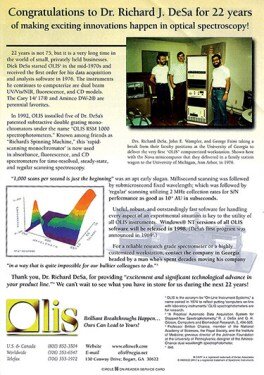Little Known Questions About Spectrophotometers.
Little Known Questions About Spectrophotometers.
Blog Article
Uv/vis/nir for Beginners
Table of ContentsThe 3-Minute Rule for Circular DichroismCircular Dichroism Can Be Fun For EveryoneAll about SpectrophotometersThings about Circularly Polarized LuminescenceFacts About Spectrophotometers Uncovered

Spectrophotometry is most commonly used to ultraviolet, visible, and infrared radiation, modern-day spectrophotometers can question broad swaths of the electro-magnetic spectrum, including x-ray, ultraviolet, visible, infrared, and/or microwave wavelengths. Spectrophotometry is a tool that depends upon the quantitative analysis of molecules depending on how much light is taken in by colored compounds.
More About Circularly Polarized Luminescence
A spectrophotometer is commonly utilized for the measurement of transmittance or reflectance of options, transparent or nontransparent solids, such as polished glass, or gases. Lots of biochemicals are colored, as in, they soak up noticeable light and for that reason can be measured by colorimetric treatments, even colorless biochemicals can typically be converted to colored compounds suitable for chromogenic color-forming responses to yield compounds ideal for colorimetric analysis.: 65 However, they can likewise be developed to measure the diffusivity on any of the listed light ranges that typically cover around 2002500 nm using different controls and calibrations.
An example of an experiment in which spectrophotometry is used is the determination of the balance constant of a service. A certain chemical reaction within a solution may occur in a forward and reverse direction, where reactants form items and items break down into reactants. At some point, this chemical response will reach a point of balance called a balance point.
The Greatest Guide To Uv/vis/nir
The amount of light that goes through the service is indicative of the concentration of particular chemicals that do not permit light to travel through. The absorption of light is due to the interaction of light with the electronic and vibrational modes of molecules. Each type of particle has a specific set of energy levels related to the makeup of its chemical bonds and nuclei and therefore will absorb light of particular wavelengths, or energies, leading to special spectral homes.
Making use of spectrophotometers covers numerous scientific fields, such as physics, products science, chemistry, biochemistry. UV/Vis/NIR, chemical engineering, and molecular biology. They are widely used in lots of industries including semiconductors, laser and optical production, printing and forensic assessment, along with in labs for the study of chemical substances. Spectrophotometry is often used in measurements of enzyme activities, decisions of protein concentrations, decisions of enzymatic kinetic constants, and measurements of ligand binding reactions.: 65 Eventually, a spectrophotometer is able to determine, depending on the control or calibration, what compounds exist in a target and exactly how much through calculations of observed wavelengths.
This would come as a solution to the previously created spectrophotometers which were not able to soak up the ultraviolet properly.
Uv/vis/nir - An Overview
It would be found that this did not offer satisfactory results, for that reason in Model B, there was a shift from a glass to a quartz prism which enabled for much better absorbance results - circular dichroism (https://www.abnewswire.com/companyname/olisclarity.com_129679.html#detail-tab). From there, Design C was born with an adjustment to the wavelength resolution which wound up having 3 units of it produced
It was produced from 1941 to 1976 where the price for it in 1941 was US$723 (far-UV accessories were a choice at additional cost). In the words of Nobel chemistry laureate Bruce Merrifield, it was "probably the most crucial instrument ever established towards the development of bioscience." Once it ended up being stopped in 1976, Hewlett-Packard produced the very directory first commercially readily available diode-array spectrophotometer in 1979 called the HP 8450A. It irradiates the sample with polychromatic light which the sample absorbs depending upon its properties. It is transferred back by grating the photodiode variety which detects the wavelength area of the spectrum. Ever since, the development and application of spectrophotometry gadgets has increased profoundly and has actually turned into one of the most ingenious instruments of our time.

Fascination About Circular Dichroism
Historically, spectrophotometers utilize a monochromator including a diffraction grating to produce the analytical spectrum. The grating can either be movable or repaired. If a single detector, such as a photomultiplier tube or photodiode is used, the grating can be scanned stepwise (scanning spectrophotometer) so that the detector can determine the light strength at each wavelength (which will correspond to each "step").
In such systems, the grating is repaired and the strength of each wavelength of light is determined by a different detector in the selection. In addition, most contemporary mid-infrared spectrophotometers utilize a Fourier change technique to obtain the spectral info - https://www.bitchute.com/channel/ZeGQl0AaiFBC/. This strategy is called Fourier change infrared spectroscopy. When making transmission measurements, the spectrophotometer quantitatively compares the portion of light that travels through a referral service and a test option, then electronically compares the intensities of the 2 signals and calculates the portion of transmission of the sample compared to the recommendation standard.

Report this page